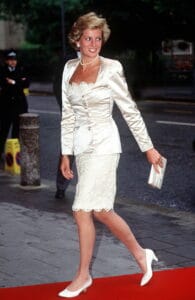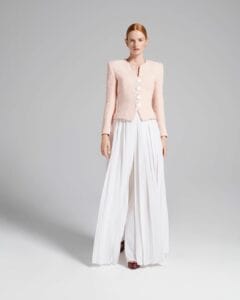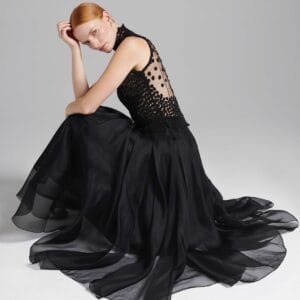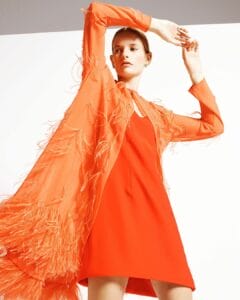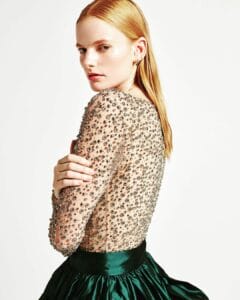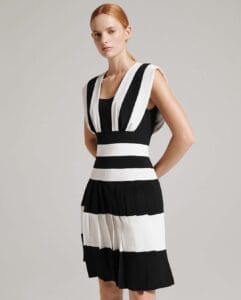Bruce Oldfield has found a way to thrive outside of the frantic pace of the industry.
Words by Christopher Blackmon
British designer Bruce Oldfield lives in a beautiful flat in the South of London, on a quiet street with lots of light. At 72, he has lived the glamorous life of a successful designer. He’s had it the old way: television appearances, highly produced runway shows, a beautiful home, and dressing the ultimate celebrities of our time, including the eternal one, Diana, Princess of Wales.
But over the past two years, Oldfield has embodied a new kind of success, unlocked only by the streamlining of his whole design process—indeed, of his entire business. He continues to dress many of the world’s devastatingly wealthy and powerful women, or those that are adjacent to the world’s devastatingly wealthy and powerful men. But about two years ago, he started doing things radically differently: he makes all of his clothes to order. He prioritizes loyal clientele and excellent white glove customer service, with Oldfield shoppers coming to the designer’s flat for fittings.
This revamped couture operation is profitable, manageable, and one that hums along nicely. He doesn’t have to compromise on the quality of his clothes, and dresses who he wants, how he wants…and that includes people like Camilla, the future Queen Consort of England.
Oldfield’s career—one that starts in the 1970’s—is in direct opposition to the fashion business model that has dominated the past three decades. That model has meant more seasons, more shows, more stores, and a bigger, ever expanding global footprint. Today, Oldfield should serve as a case study, a template, into what independent life in fashion could be for designers who either don’t find themselves knighted by the sword of LVMH, or whose business doesn’t need to be or can’t be scaled to a global level. Because of these industry shifts in how business is done in fashion, the traditional ways in which Oldfield works has now cycled back to seem fresh, sustainable, even radical.
Could more of the industry swing towards doing business in this old school-meets-ingenious way? “I hope so,” Oldfield says. “I decided on something like the 18th of March, two years ago, that perhaps the time was right to re-think.”
Oldfield’s story has a harsh beginning; he was born a mixed-race orphan in bleak North Yorkshire, England. “What an upbringing,” says Professor Mark-Evan Blackman, the chairperson of the Menswear program at the Fashion Institute of Technology in New York, who has closely followed Oldfield’s career. “He basically had less than nothing to start with, and you realize how strong the will is.” He adds, “There is nothing insurmountable to one’s desire and drive, and he personified that.”
Graduating from Central Saint Martins in the early 1970s, Oldfield was a quickly recognized talent. One of his first clients was Bianca Jagger; the relationship started when she needed a tailor to nip and tuck at a few suits she had bought from the Rita Hayworth estate. From that meeting on, his trajectory would continue to be a bumpy rise. Then came the department store Henri Bendel in New York, who invited him over to America to design a collection for the store. There was the sojourn to Paris, freelancing for Parisian firms in the day, and dancing the night away at Le Sept deep into the night. But ultimately Bruce would come back to London, starting his eponymous business with a friend in 1975, funded by a small loan from Banardo’s, the U.K. charitable organization that provided housing for him as a child.
It was a hard uphill graft, but by 1985, his business was reported to have had yearly revenues of about 1.5 million pounds, according to a Thames TV featurette on the designer. (Adjusted for inflation and converted, that would be a little under 6 million U.S. dollars today.) But Oldfield nursed ambitions of building a British equivalent to Giorgio Armani, who at that time was scaling his superb Italian tailoring into a global language of luxury. For a time, Oldfield’s high-profile, very public clientele suggested his dream might come to fruition. He dressed the cultural arbiters of the era, creating a singular mix of power and glamour with his metallic gowns and sharp tailoring: women like Jerry Hall, Joanna Lumley, and Jemima Khan, and of course, Diana, Princess of Wales.
-

- Princess Diana in a zesty but expertly fit gown by Bruce Oldfield, arriving at a party in July of 1989. / TIM GRAHAM
-

- And again in Oldfield in 1990: a stylish but essentially royal white saint and lace skirt suit. / TIM GRAHAM
With Diana, a decade-long friendship was struck, and she would become a trusted client throughout the 1980s. “[British] Vogue was charged with the job of looking after her wardrobe once the engagement [to Charles] was made,” Oldfield says of the beginning of their partnership. The editors of the magazine selected about ten designers, and “we were asked to send in three samples each to the editor’s office. Diana went there and had a big try-on session.” She chose two of Oldfield’s looks. The harmony between the princess and Oldfield was confirmed when the new royal couple returned from their honeymoon, Diana stepping off the aircraft in “a fitted cinnamon-colored gabardine wool suit with a peplum,” Oldfield recalls.
“Bruce will only allow you to go out looking elegant—never mundane and never vulgar.”
Throughout the 1980s, Oldfield would become known as the elite society dresser. A designer that the land-and-gentry set could trust, someone who possessed the skills to convincingly wrap their bodies in cloth in a way that was flattering and satisfied the peculiar criteria that comes with having a title or a name with the weight of reputation. One private client once remarked to the designer, “It’s so difficult to buy things that are royal enough for us.” Meaning clothes that are chic and of a certain dignity and restraint. Oldfield always had the answer.
-

- Oldfield’s customers order looks like these by coming to his flat and having a conversation about their needs and desires. Then a toile is created and multiple fittings take place, a process that takes between two and four months. / Bruce Oldfield / Instagram
Oldfield’s dresses were, as they are now, elegant confections, cut with a clean line, with a bit of sparkle and frisson mixed in. His structured dresses are cut sexily close to the body, but constructed so they look current, stately, rather than overtly sexy. A layered long chiffon skirt colored chocolate brown has a grandness, but the ease of a tennis skirt. Romilly, Lady McAlpine (once dubbed the “First Lady Of Couture”), who has been a client for years, explains the appeal of his clothes thus: “Bruce will only allow you to go out looking elegant—never mundane and never vulgar. Wearing [him] makes you feel special, and yet somehow effortless.”
Diana’s relationship would famously flame out with Charles in the early 1990s, and when that happened, so did her relationship with Oldfield. I gather that he thinks she wanted a new look to fit her new life. The clothes became Gianni Versace and John Galliano: shorter, hipper, and tighter, as she was freed from the constraints of the ever-present royal courtier eye.
In an attempt to globalize his brand, in the style Armani had achieved in Italy, Oldfield followed the footsteps of many of his design peers. Product licenses and a ready-to-wear diffusion-line called 1992 (named after the year the line was established) were trials to more cash. By the mid-90s, however, fashion would experience the birth of a new generation of designers: news making, transgressive creatives that saw the world differently—Alexander McQueen, Galliano, Hussein Chalayan—and Oldfield, sensing the shift and distance, quietly stepped away from under the attention of the press.
There were internal issues at the company as well: the loss of integral staff, and a post-financial crash banking environment that made loans harder to come by. To keep Bruce Oldfield afloat came at a heavy price: the man born to no home, would have to sell his hard-fought Elm Park Gardens he bought in 1986 only four years later, in 1990.
By 1993, Oldfield decided to exit his ready-to-wear and licenses, and focus on made-to-measure couture. Ready-to-wear, he realized, was a company category “where the money was always lost.” What seemed to sustain the Oldfield brand was his quieter, made-to-measure service. Releasing himself of the runway, Oldfield found a business that quietly ran itself, for once letting him focus on what he does best, successfully designing for a certain kind of woman.
But by 2020, wanting a calmer life, and sensing the tectonic plates of fashion moving again, Oldfield decided the business needed to quickly evolve to keep going and remain under his control. To achieve this shift meant a huge slash in overhead: he let go of much of his personnel and closed his tony Beauchamp boutique. His timing would prove perfect. Two days later, Prime Minister Boris Johnson would impose some of the most restrictive lockdown measures in the western world. For fashion, that meant its whole ecosystem would halt for months.
-

- Two looks from Bruce Oldfield’s new focus on made-to-order clothes for a small clientele. Bruce Oldfield / Instagram
Oldfield, during his time spent in the shadows of high fashion, tended to what would save him during lean economic times: his client list. “I knew I could make a go of it, just by talking to my clients. It wasn’t waiting three weeks for a reply to the email, it was two minutes later, ‘Oh my God, I wondered where you were?’” As commerce cooled off for most, Bruce continued to receive orders. Orders from years long, loyal customers who wanted looks, especially gowns, for when lockdown would be over. His business is now mostly geared to designing stately garments for events, evening, or weddings.
“[The whole transition] was financed by my clients,” he says. “It really is fantastic.”
Now, the Oldfield universe is a manageable couture operation that is quiet, but robust and turns a profit, providing custom garments to a select list of women who routinely go to him to be dressed in his vision. It’s an eclectic clientele: a private 32-year-old millionaire from an infamous family, women who reside behind stone walled estates, and high-profile figures like Camilla, Duchess of Cornwall. “She’s a good egg,” he says of his most famous client. Regarding her outfits, she comes to him for royal attire that will uphold being scrutinized by many: that can look like a floor-length dress of layered delicate fabric the color of soft powder blue, cut with a simple, regal neckline and sheer sleeves, all encrusted with 3D embroidery that thins out towards the hem like falling snow. Most do not realize it is Oldfield’s work, which for him is fine. It’s an example of the quiet path of luxury that he has adopted all those years ago.
To be a client of Oldfield’s is to experience a process not unlike what happens within the gilded couture salons of Paris. His clients enter the drawing room of his Battersea Park home and studio, and sit on its lush sofas and chairs, as Bruce starts to talk and sketch. Upon entering, his patrons are usually drawn to the wall where he’s tacked up inspiration, sketches, bits of fabric that serves as an external collage of his brain. Once they are seated, a back-and-forth exchange takes place between Oldfield, with his seasoned eye, and the client. After initial sketches, his technician measures their bodies, a toile is made, fittings are performed, and then the garment is cut, constructed, and finished, all by hand. It’s a process that takes anywhere from two to four months.
“They want to have a feeling of glamour and magic,” Oldfield says of his clients’ needs. “These are intelligent women. They want to look like it’s not too much trouble to get dressed.” They want to show off their physical forms tastefully: “I don’t have any clients who want to wear a muumuu.”
-

- …And a glitzy one. Many of Oldfield’s clients sustained his business over the past two years by ordering gowns for post-lockdown life. / Bruce Oldfield / Instagram
I ask Bruce if he was happy how a life spent being mainly independent in fashion has unfurled. There’s a moment’s pause, and he ultimately tells me yes. I believe that, but it’s hard not to have a nagging feeling that he still ponders “what if” regarding the Armani-empire he so admired. “I’m not trying to grow the business. I need to do things that I know, and things that I enjoy.”
“These are intelligent women. They want to look like it’s not too much trouble to get dressed….I don’t have any clients who want to wear a muumuu.”
Today, money is no longer a problem. He has rebuilt the Oldfield universe for a modern age, albeit at a more peaceful pace, centered around silhouette, handwork, and technique.
Now, it seems, the world is catching up to what Oldfield realized all those years ago. Forced to play on a post-pandemic field, designers younger than Oldfield are returning to (or finding) this client-led, made-upon-order business model. There are examples in all the major fashion capitals: Ralph Rucci in New York, Giles Deacon in London, and Olivier Theyskens, a recent convert, in Paris. Even conglomerate fashion, like Demna led Balenciaga, has recognized this shift, installing their e “couture salon,” a proof of concept that this style of operation in high fashion is valid.
His story keeps getting better too. The designer has experienced a resurgence of interest in his work. Both through Camilla, who recently wore Oldfield for a portrait taken by Jamie Hawkesworth, and an overall cultural re-fascination with the British royals. The forthcoming season of The Crown, which will debut in November, will feature Elizabeth Debicki playing Diana in the throes of her Oldfield phase.
“I feel I’ve tapped into a marvelous place,” he says of his evolved life and business model.
A place wholly his own.
– – – – – –
This story originally appeared in harpersbazaar.com




